Reenactment, Repetition, Return. Ion Grigorescu’s Two Dialogues with Ceausescu
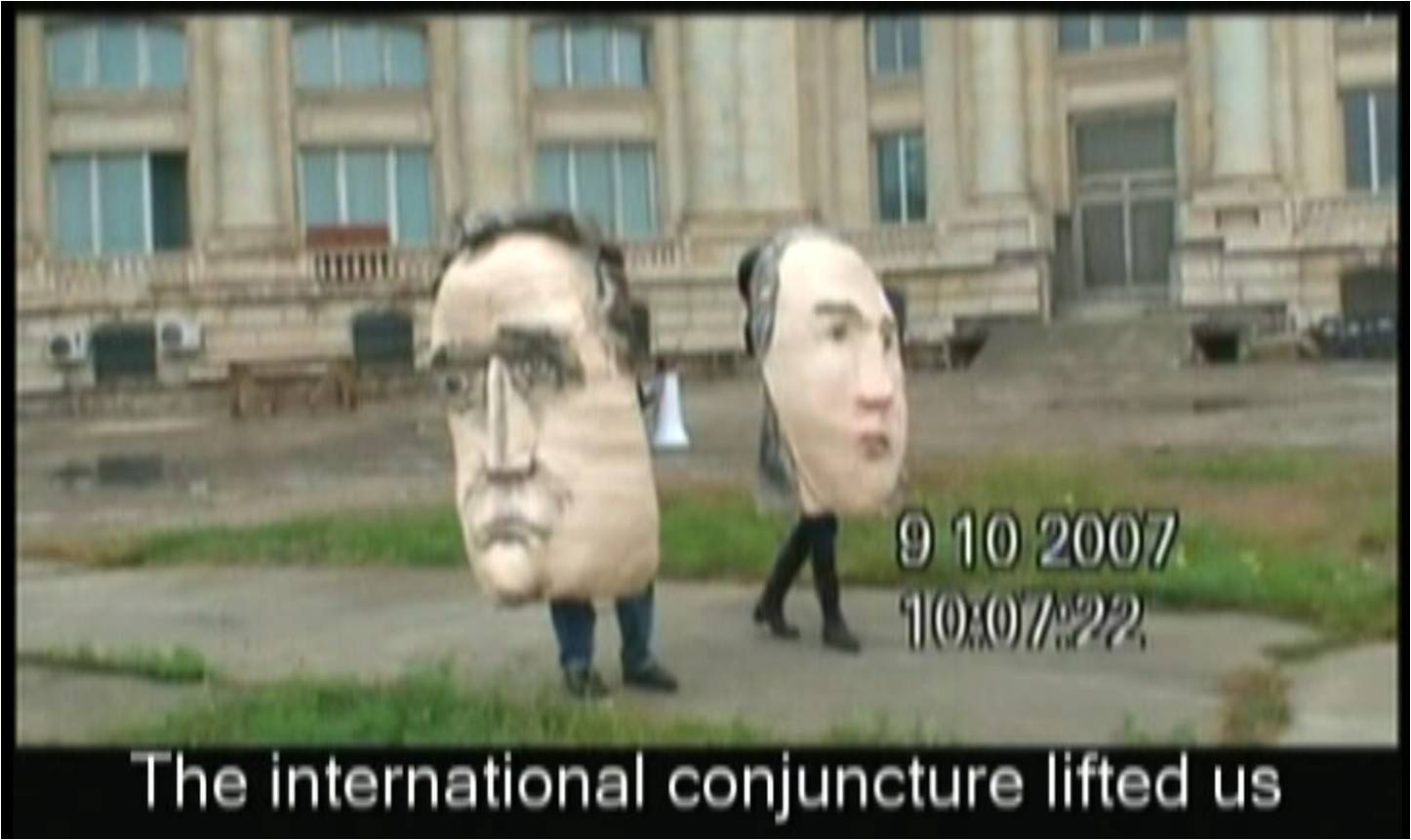
In 1978 the Romanian artist Ion Grigorescu shot an 8mm film of a performance entitled Dialogue with Ceausescu, which he conducted alone in the privacy of his studio. The period following Nicolae Ceausescu’s accession to power after he succeeded Gheorghe Gheorghiu-Dej in 1965 seemed to correspond with a softening of the communist regime. Censorship of the arts abated somewhat, with exposure to the art of Western Europe and the United States authorized, in particular by means of exhibitions.(See Magda Carneci, Art et pouvoir en Roumanie 1945-1989 (Paris: L’Harmattan, 2007) pp. 121, 129, and 133.) However it wasn’t long before Romania closed herself off again and from the early 1970s the political outlook began to harden. By the time of his performance of 1978, in which Grigorescu holds the president to account for his rule over the country, this work could only be made in utmost secrecy.
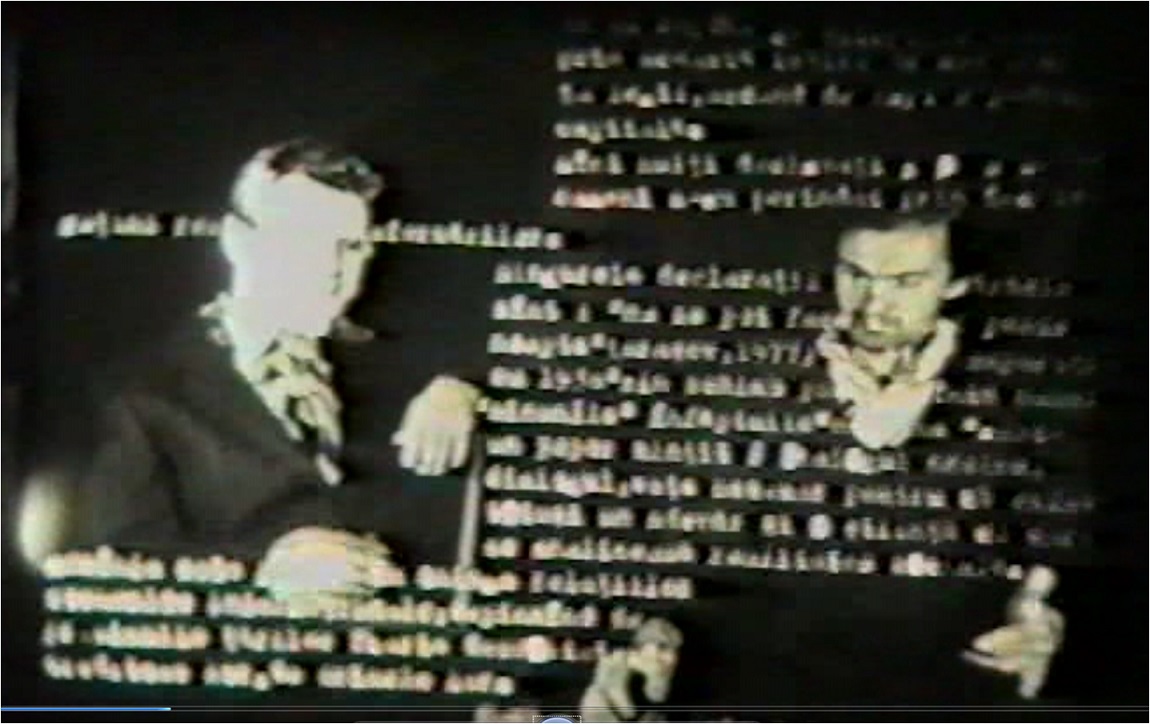
After completing his studies at the Bucharest Fine Arts Institute in 1969, Grigorescu began working with different media – painting, photography, film, performance art and comics. His production can be divided into two categories. On the one hand, the artist exhibited his work in public spaces or published it in the magazine Arta Plastic?. Meanwhile, on the other hand, he created work that only a restricted circle of friends could see when it was displayed at events he organized secretly at his home. In Dialogue with Ceausescu, two figures appear talking together seated side by side in front of the camera. Grigorescu plays both roles: himself, and wearing a mask and a tie, Ceausescu. In 2007, more than seventeen years after the death of Ceausescu, who was executed in December 1989 along with his wife Elena after a summary trial, Grigorescu returned to the figure of the former president. He chose the digital medium – recording on a DVD – to shoot a Postmortem Dialogue with Ceausescu. Once again, a mask helped him portray the figure of the president answering the artist’s questions. The dialogue format is adopted again despite the changes in conditions. Grigorescu is no longer forced to hide in his studio in order to work. He shoots this video on the very site of the palace that Ceausescu had had built as his residence.(This “People’s House,” as the inhabitants of Bucharest still call it today despite its official name, the “Palace of the Parliament,” is closely associated with the figure of Ceausescu, who did not shrink from displacing tens of thousands of people and razing architectural sites dating from the first half of the eighteenth century in order to realize his colossal project.) In the first part of the 2007 video, we see the president and his wife walking outside the Palace of the Parliament. More accurately, the couple is seen strolling in front of the section of the building that has been home to the National Museum of Contemporary Art since 2004. Nicolae and Elena Ceausescuare represented through outsized masks, the first of which is worn by Grigorescu and the second by his assistant. The second part takes place inside the building. As in the 1978 film, Ceausescu and Grigorescu conduct their conversation seated facing the camera.
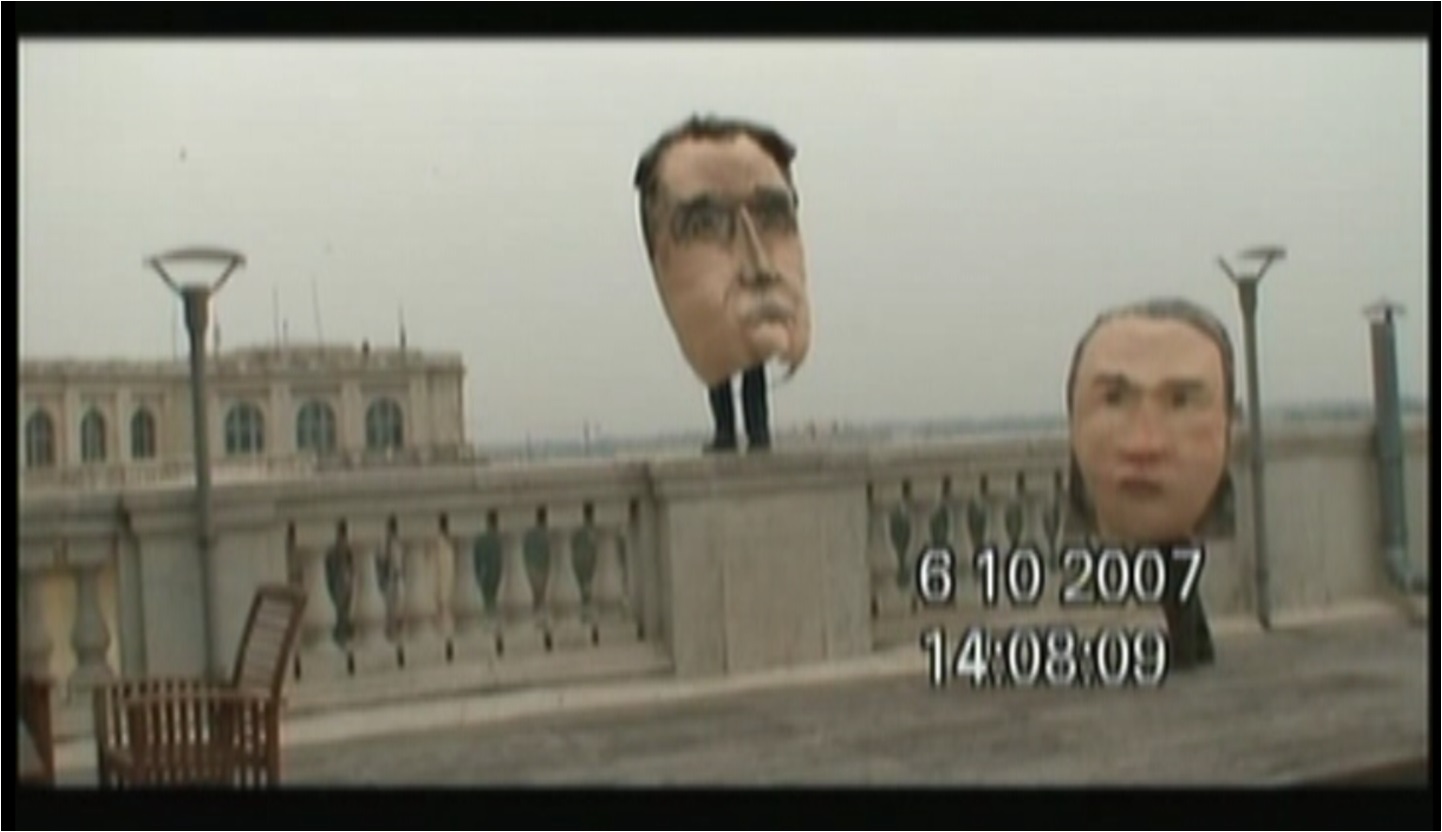 How are we to understand the persistence of the dialogue between the artist and the president in the 2007 video? The longevity of this element is all the more surprising in that everything else has changed, the techniques used, the site where the DVD was shot, and of course Romania’s political system. Since Postmortem Dialogue with Ceausescu, like the Dialogue of 1978, consists of a performance which the artist records on film, I will examine the relationship between these two works through the prism of “reperformance” and “reenactment.” I will consider these terms as synonyms inasmuch as they usually refer back to the revival of earlier performances. However, while the usage of the term “reperformance” is specific to the arts, “reenactment” has a broader application, and in particular can be taken to mean the historical reconstruction of periods or of military and civic events. Repetition and return are two other concepts which will allow me to consider in more depth the link between Postmortem Dialogue and the 1978 Dialogue. What will be of particular interest when analysing these works in these terms is to discover what, if any, parallels might be drawn with the interrelation of today’s Romania with its recent past.
How are we to understand the persistence of the dialogue between the artist and the president in the 2007 video? The longevity of this element is all the more surprising in that everything else has changed, the techniques used, the site where the DVD was shot, and of course Romania’s political system. Since Postmortem Dialogue with Ceausescu, like the Dialogue of 1978, consists of a performance which the artist records on film, I will examine the relationship between these two works through the prism of “reperformance” and “reenactment.” I will consider these terms as synonyms inasmuch as they usually refer back to the revival of earlier performances. However, while the usage of the term “reperformance” is specific to the arts, “reenactment” has a broader application, and in particular can be taken to mean the historical reconstruction of periods or of military and civic events. Repetition and return are two other concepts which will allow me to consider in more depth the link between Postmortem Dialogue and the 1978 Dialogue. What will be of particular interest when analysing these works in these terms is to discover what, if any, parallels might be drawn with the interrelation of today’s Romania with its recent past.
Reperformance, Reenactment
The questions that regularly arise when we tackle performance from the point of view of reperformance or reenactment touch upon the notion of the original. That may seem paradoxical when the practice of performance in the 1970s corresponded to an endeavor to destabilize the work of art as a unique material entity.(On dematerialization as the noncoincidence of the work of art and a material object, see Ileana Parvu, “Introduction,” in Objects in Progress (Geneva: MetisPresses, 2012) pp. 21-32.) In 1993, the art historian Peggy Phelan introduced a clear separation between performance as such and the capturing of performance: “Performance’s only life is present. Performance cannot be saved, recorded, documented, or otherwise participate in the circulation of representations of representations: once it does so, it becomes something other than performance.”(Peggy Phelan, Unmarked. The Politics of Performance (London and New York: Routledge, 1993) p. 146.) It is with its disappearance that the study of performance can begin. In 1998, however, Phelan, referring now to Rosalind Krauss, proposed to rethink the relationship between the original and its record: “Krauss has demonstrated that there is no original until the copy is operative. Thus, the meaning of originality is dependent on the copy, the forgery, the counterfeit.”(Phelan, The Ends of Performance (New York and London: New York University Press, 1998) p. 9.) Krauss’s assertion gives way to a topos of postmodern theory: it is from the perspective of reproduction that the notion of the original arises. Most of the time, however, originality is only mentioned in the same breath as performance in order to deconstruct it. Amelia Jones thus points to the case of a reenactment reproducing a performance that probably never happened.(Amelia Jones, “‘The Artist is Present’: Artistic Re-enactments and the Impossibility of Presence,” The Drama Review, Spring 2011, p. 29.) Seven Easy Pieces, which Marina Abramović performed at the Guggenheim Museum over the course of one week in November 2005, included the piece by Valie Export entitled Action Pants: Genital Panic (1969). According to recent scholarship, it is quite possible that the Austrian artist never actually presented the piece in a theater before an audience. Action Pants: Genital Panic might exist only as a few black-and-white photographs showing the artist seated or standing, wielding a submachine-gun, legs apart, and wearing a pair of crotchless trousers that reveal her genitals. What is supposed to be the documentation is, in fact, the work of art. By basing her own piece on this material, Abramović did not apparently reproduce Export’s performance, she produced it. The copy here constitutes the original.
The original and the records of the original are constantly switching roles. When asked by Nancy Spector about Export’s reperformance of Action Pants, Abramović answers:
“Looking at the images, you see that one was a pose for the poster, one was the real performance in the theater [sic], and there are different ways she is dressed, and different elements, so it was difficult for me to decide what I should do. In the end, I thought, given the circumstances, it was best for me to create an image.”(Marina Abramović, “Interview with Nancy Spector,” Seven Easy Pieces (Milan: Charta, 2007) p. 22.)
Abramović’s response highlights the impossibility of a reproduction ever being identical to the original. Reperformance or reenactment are always part recreation. Choices have to be made, decisions taken.
However, the reinvention part inherent in every reperformance or reenactment does not suffice to account for the way in which Grigorescu’s Postmortem Dialogue refers back to his 1978 Dialogue. Indeed, a reperformance or a reenactment depends on a work which becomes the model to be reconstructed. The paradox of the 2007 video is that whilst it is a return to the dialogue form of the 1978 film, it is not a reconstruction and thus cannot grant the dialogue of 1978 the status of the original. Like the latter, it too consists of an independent work.
Technique
The 1978 Dialogue can be seen as a collection of technical failures. Grigorescu used a defective second-hand standard 8mm camera. Since he played both roles, he ran the film through the camera twice. Against a black background, he filmed first the left half of the image, then reloaded the film in the camera and recorded himself again, now on the right half of the image. The film is silent, with the dialogue appearing as overlaid text on the screen. Grigorescu thus worked the film negative a third time in order to have the text visible in the image, although technical flaws in the end made it impossible to read the dialogue.
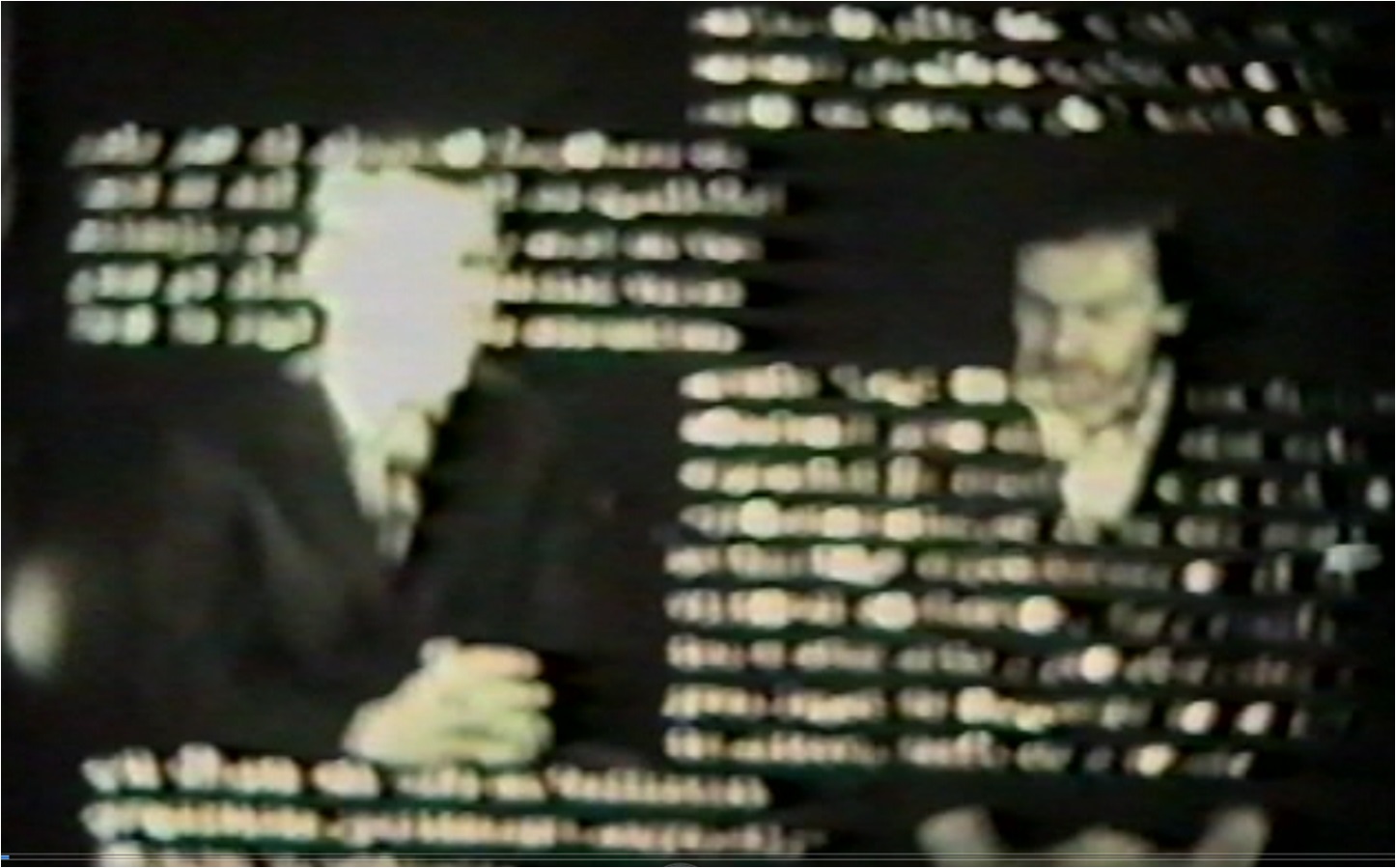 But can we take the technical failures of this Dialogue as something other than a defect, no longer seeing them as a result of the Romanian economic shortage but as artistic decisions in their own right? The 2007 Dialogue helps us to view the earlier piece in a different light. In 2007 Grigorescu had at his disposal the wherewithal to make a video free of technical glitches. During a conversation I had with the artist in November 2009 he referred to the possibility in 2007 of “correcting” his 1978 work, and hastened to add that that was precisely what he had not wanted to do. Indeed, far from correcting earlier technical imperfections his Postmortem Dialogue brings them to the fore. If the sameproblems arise from different means, it may signify that these are not in fact problems, but ways in which the material and the technique make sense and produce meaning.
But can we take the technical failures of this Dialogue as something other than a defect, no longer seeing them as a result of the Romanian economic shortage but as artistic decisions in their own right? The 2007 Dialogue helps us to view the earlier piece in a different light. In 2007 Grigorescu had at his disposal the wherewithal to make a video free of technical glitches. During a conversation I had with the artist in November 2009 he referred to the possibility in 2007 of “correcting” his 1978 work, and hastened to add that that was precisely what he had not wanted to do. Indeed, far from correcting earlier technical imperfections his Postmortem Dialogue brings them to the fore. If the sameproblems arise from different means, it may signify that these are not in fact problems, but ways in which the material and the technique make sense and produce meaning.
Let’s look at two elements of the Dialogue films which show how these technical defects contribute to the very meaning of the works. The black background was necessary in the 1978 Dialogue to achieve the illusion of a dialogue between two characters played by one man. It ensures that part of the film surface remained unexposed and thus allowed for the simultaneous presence, in the image, of what was shot in succession, i.e., Grigorescu as both Ceausescu and in his own role as the artist. But the black background is also the source of the confined, enclosed tonality that pervades the film. This feeling that the eye cannot get out, cannot escape, is also present in the 2007 Dialogue. The conversation may be taking place in front of a window but it overlooks a narrow inner courtyard of the Palace of the Parliament. Despite the window, the image is one of enclosure, leading nowhere. The wall which the viewer is presented with in the 2007 video is the visual equivalent of the black backdrop in the film of 1978.
What is striking in the 1978 film is that there is no communication between the two characters that are supposed to be in dialogue. Each of them is isolated, confined as if in his own bubble. There are of course technical reasons for that. Grigorescu played and filmed each character separately. The connection between the moments when one character speaks (asks or answers a question) and the other character listens is broken most of the time. Both characters remain quiet while listening, or, on the contrary, speak and gesticulate at the same time. This technical defect points to the impossibility of an anonymous citizen communicating with Ceausescu, and vice versa. Each character bears with him the space to which he is consigned, and these two spaces do not coincide. There is no homogenized, unified space that two people can enter and share. We could say that it is as if each character existed in his own layer of the image. Any meeting between the layers of this stratified projection is unlikely. The 1978 film materializes the insurmountable gap between the president and the public.
 If seen as a mere defect produced by the poor technical means at the artist’s disposal, this lack of communication could have been “corrected” in the video of 2007. Nothing of the sort happened. The Postmortem Dialogue with Ceausescu creates the same impossibility of being and speaking together. However, in the later work, it is not the space that the two characters cannot share. A still from the 2007 video shows them sitting together. Grigorescu is clearly addressing Ceausescu since the artist is turned to face him. So the lack of communication springs here less from the impossibility of sharing the same space than from the impossibility of sharing the same time. The video gives a very precise indication of time by displaying in the lower right corner of the image the date and time the piece was recorded. Thanks to this indication, it is obvious for the viewer that Ceausescu’s answers were not shot in sequence with Grigorescu’s questions. Roughly speaking, Grigorescu first recorded his questions one after the other, then played Ceausescu’s role, giving all the answers in a row. The editing of the video puts questions and answers in the right order but it also acknowledges clear cuts in the passage from one speaker to the other. Several seconds pass each time between the moment when Grigorescu finishes asking his question and when Ceausescu begins to answer. These lapses in time are akinto continuity errors. They disrupt the illusion of filmic continuity and suggest that the film itself is but a fragment of a greater whole. In order to conceive of film’s ability to convey something beyond its limits, Deleuze devised the notion of “the Open:” “False continuity is neither a connection of continuity, nor a rupture or a discontinuity in the connection. False continuity is in its own right a dimension of the Open, which escapes sets and their parts. It realizes the other power of the out-of-field, this elsewhere or this empty zone, this ‘white on white which is impossible to film.’”(Gilles Deleuze, Cinema 1: The Movement-Image, translated by Hugh Tomlinson and Barbara Habberjam (London: The Athlone Press, 1986) p. 28.) The philosopher developed “the Open” on the basis of a remark made about Dreyer’s film, Gertrud. When asked about the whereabouts of the lead character, Jean Narboni, Sylvie Pierre and Jacques Rivette replied to the effect that Gertrud had disappeared “in the splicing.”(Deleuze, p. 28. The conversation on film editing between Jean Narboni, Sylvie Pierre and Jacques Rivette was published in March 1969 in Cahiers du cinéma.) Similarly, the missing seconds make Postmortem Dialogue a film that opens onto a totality beyond its own limits and they indicate a greater whole, certain parts of which remain invisible. They also testify to something that is missing, the unity of time. Each character seems to follow his own temporal thread. There isn’t any interaction between the two speakers. The time lapses refer to the impossibility of filming what has nevertheless to be seen – Deleuze’s the Open – and since each character is in his own temporal bubble, they materialize the divergence of time between the dead and the living.
If seen as a mere defect produced by the poor technical means at the artist’s disposal, this lack of communication could have been “corrected” in the video of 2007. Nothing of the sort happened. The Postmortem Dialogue with Ceausescu creates the same impossibility of being and speaking together. However, in the later work, it is not the space that the two characters cannot share. A still from the 2007 video shows them sitting together. Grigorescu is clearly addressing Ceausescu since the artist is turned to face him. So the lack of communication springs here less from the impossibility of sharing the same space than from the impossibility of sharing the same time. The video gives a very precise indication of time by displaying in the lower right corner of the image the date and time the piece was recorded. Thanks to this indication, it is obvious for the viewer that Ceausescu’s answers were not shot in sequence with Grigorescu’s questions. Roughly speaking, Grigorescu first recorded his questions one after the other, then played Ceausescu’s role, giving all the answers in a row. The editing of the video puts questions and answers in the right order but it also acknowledges clear cuts in the passage from one speaker to the other. Several seconds pass each time between the moment when Grigorescu finishes asking his question and when Ceausescu begins to answer. These lapses in time are akinto continuity errors. They disrupt the illusion of filmic continuity and suggest that the film itself is but a fragment of a greater whole. In order to conceive of film’s ability to convey something beyond its limits, Deleuze devised the notion of “the Open:” “False continuity is neither a connection of continuity, nor a rupture or a discontinuity in the connection. False continuity is in its own right a dimension of the Open, which escapes sets and their parts. It realizes the other power of the out-of-field, this elsewhere or this empty zone, this ‘white on white which is impossible to film.’”(Gilles Deleuze, Cinema 1: The Movement-Image, translated by Hugh Tomlinson and Barbara Habberjam (London: The Athlone Press, 1986) p. 28.) The philosopher developed “the Open” on the basis of a remark made about Dreyer’s film, Gertrud. When asked about the whereabouts of the lead character, Jean Narboni, Sylvie Pierre and Jacques Rivette replied to the effect that Gertrud had disappeared “in the splicing.”(Deleuze, p. 28. The conversation on film editing between Jean Narboni, Sylvie Pierre and Jacques Rivette was published in March 1969 in Cahiers du cinéma.) Similarly, the missing seconds make Postmortem Dialogue a film that opens onto a totality beyond its own limits and they indicate a greater whole, certain parts of which remain invisible. They also testify to something that is missing, the unity of time. Each character seems to follow his own temporal thread. There isn’t any interaction between the two speakers. The time lapses refer to the impossibility of filming what has nevertheless to be seen – Deleuze’s the Open – and since each character is in his own temporal bubble, they materialize the divergence of time between the dead and the living.
Day and Night
The emergence of these worlds running spatially and temporally on parallel tracks, existing separately side by side, makes the dialogue with Ceausescu seem as if it were tinged by unreality. Grigorescu’s “interview” of Ceausescu was of course completely unreal, even before the president’s death. But there is more at stake here with regard to the question of unreality. The 1978 Dialogue in particular constantly evokes the unreality of dreams. Grigorescu is an assiduous reader of Sigmund Freud, as evidenced in the many notes he has taken reading On Dreams (1901).(Ion Grigorescu, Diaries 1970-1975, Georg Schöllhammer and Andreiana Mihail, eds., translated by Nicolae Dumitru (Berlin: Sternberg Press, 2014) pp. 189-191.) Nevertheless, the artist’s interest in Freud’s writings has not stopped him from criticizing psychoanalysis. Grigorescu is less interested in the mechanism of dreams, than in the confusion between day and night engendered by dreams.(Roger Caillois wrote beautifully about night-time dreams and the uncertainty they cast over one’s waking hours. See Roger Caillois, L’incertitude qui vient des rêves (Paris: Gallimard, 1956).) The artist’s notebooks are filled with this uncertainty about what is being narrated, i.e., whether something is a dream or something that actually happened during the day. What produces confusion is the very precise indication of locations and people’s names. Grigorescu offers a very realistic frame for the unreal to arise. Take, for instance, a note dated December 25, 1975. Grigorescu is writing about celebrating Christmas at the house of a friend, the Romanian artist Geta Bratescu:
“25 Christmas at Geta. Aunt Lizica announces to me that Nanadotu is ill. A feeling that Iliuta and Aunt Lizica polarize. The formula of 5 used to work. But not now.
Iliuta gets bored quickly. I took advantage of the fact that he was not paying attention and I won the traffic signs domino game. I’m very cold when I go out. This and my visit to Ariadna will make mecatch a cold.”(Grigorescu, p. 231.)
Everything plays out in a realistic way and despite a change of font in the second paragraph – which was the artist’s typographical decision – there is no reason to suspect that we are reading the narration of a dream until the final non-sequitur: “Marica [the artist’s first wife] explains why I’m cold at the bus stop: ‘He’s got no more teeth in his mouth!’”(Ibid.)
In the text of the 1978 Dialogue with Ceausescu, we recognize this same interweaving of what happens during the day and at night when dreaming. In the same way, we first notice the elements that anchor the narration in everyday reality. In the manner of a journalist, Grigorescu asks the president to explain some political and economic measures that he took, such as the “objective laws” or the “Carpati Trust.” He also returns to some expressions Ceausescu used such as “popular contentment” for a clearer picture of how the president understood them. But while we expect Ceausescu to shed new light on these questions, we also know that his answers are in fact provided by Grigorescu. As in dreams, there is only one sleeper producing the words and thoughts of the other characters.
Ceausescu as Image
 Grigorescu’s films and photographs often show the portrait of Ceausescu. Such is the case in two photographs from the 1975 series entitled Electoral Demonstration, in which monumental banners bearing the president’s image are superimposed on the crowd of demonstrators. Grigorescu’s images of Ceausescu are often photographs taken by him from his television screen (as in August 1974), or photographs of newspaper illustrations (as at the end of the 1978 Dialogue). Along with these photographs there is a painting made by Grigorescu in 1980 at the request of the head of the Communist Party from the municipal department of Bucharest. In the painting Grigorescu triples the president’s face and depicts three Ceausescus busy discussing some urban project represented as a scale model.
Grigorescu’s films and photographs often show the portrait of Ceausescu. Such is the case in two photographs from the 1975 series entitled Electoral Demonstration, in which monumental banners bearing the president’s image are superimposed on the crowd of demonstrators. Grigorescu’s images of Ceausescu are often photographs taken by him from his television screen (as in August 1974), or photographs of newspaper illustrations (as at the end of the 1978 Dialogue). Along with these photographs there is a painting made by Grigorescu in 1980 at the request of the head of the Communist Party from the municipal department of Bucharest. In the painting Grigorescu triples the president’s face and depicts three Ceausescus busy discussing some urban project represented as a scale model.
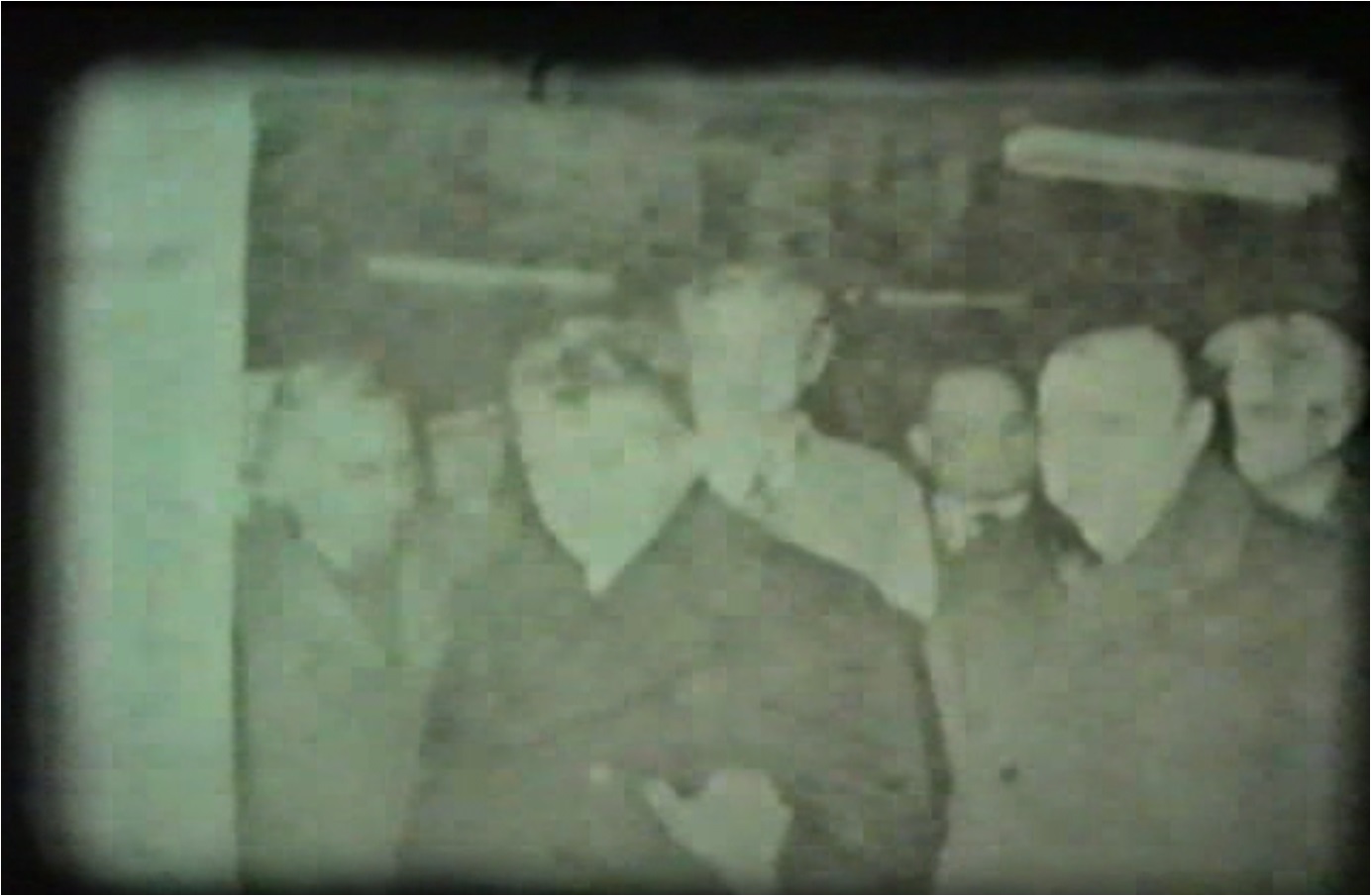 The end of the 1978 Dialogue in particular provides us with material to think about Ceausescu as image. What follows the image filmed in the newspaper is a close-up of Ceausescu’s face, and as the camera travels up we understand that we are looking at a picture resting on an easel. This last image from the 1978 film should be considered in connection with the mask Grigorescu wears to play Ceausescu’s role. Grigorescu in fact used oil paint on canvas to make his masks. Given the artist’s use of this technique, there is a strong connection between painting and mask.
The end of the 1978 Dialogue in particular provides us with material to think about Ceausescu as image. What follows the image filmed in the newspaper is a close-up of Ceausescu’s face, and as the camera travels up we understand that we are looking at a picture resting on an easel. This last image from the 1978 film should be considered in connection with the mask Grigorescu wears to play Ceausescu’s role. Grigorescu in fact used oil paint on canvas to make his masks. Given the artist’s use of this technique, there is a strong connection between painting and mask. 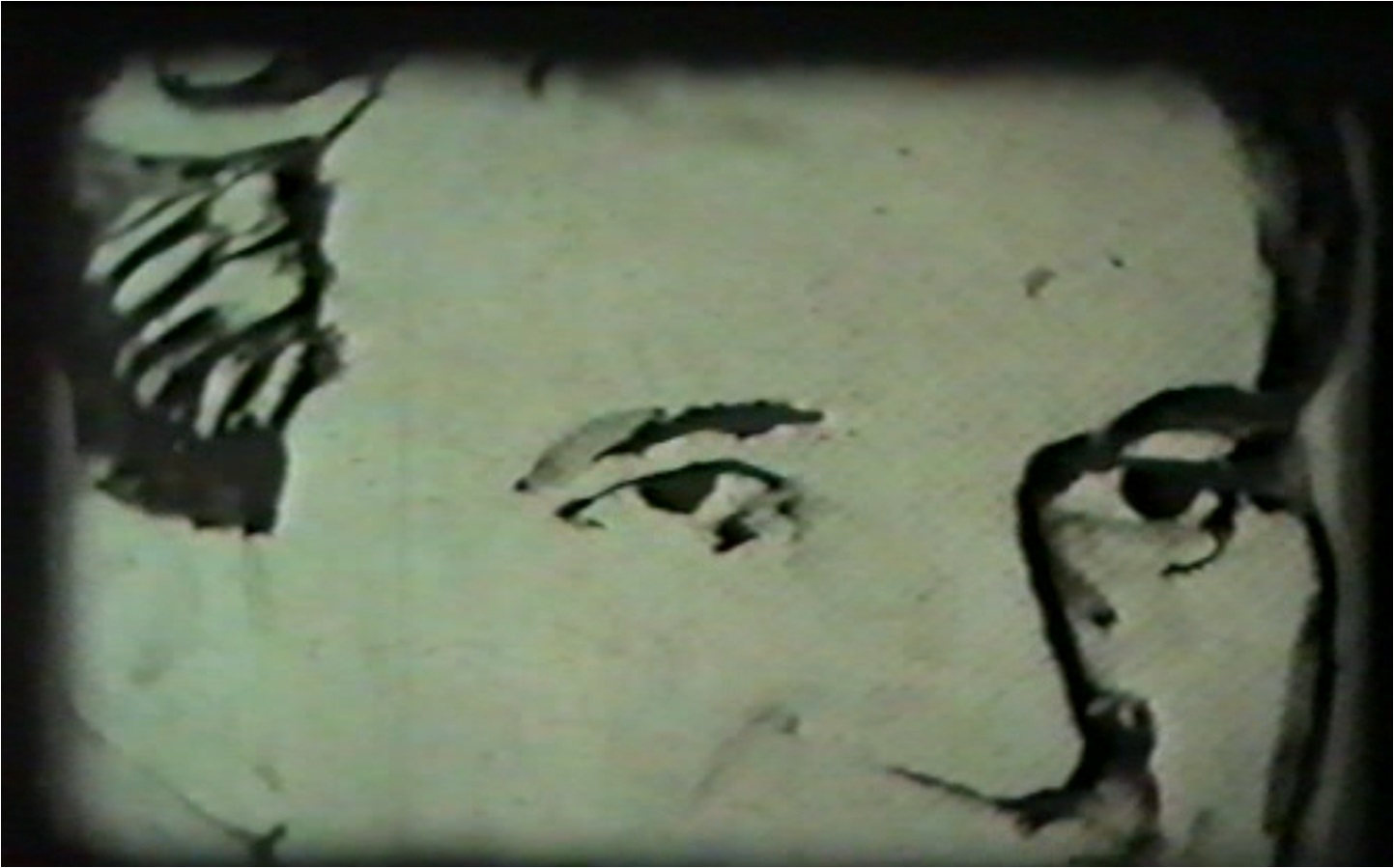 But the connection goes beyond the technique. That is, the mask is understood as a painting. In the first part of the 2007 video, the mask assumes an even greater importance. As Nicolae Ceausescu walks in front of the Palace of the Parliament with his wife before entering the buildingand starting thedialogue with the artist, the masks worn by Grigorescu and an assistant cover not only the face but the whole body.
But the connection goes beyond the technique. That is, the mask is understood as a painting. In the first part of the 2007 video, the mask assumes an even greater importance. As Nicolae Ceausescu walks in front of the Palace of the Parliament with his wife before entering the buildingand starting thedialogue with the artist, the masks worn by Grigorescu and an assistant cover not only the face but the whole body.
Once filmed, the mask generates a presence. Masks worn during a performance allow us to understand that a particular performer is representing a particular character. In the 1978 film, the image – and this is certainly due to the poor technical quality of the film – really does make the viewer believe that the character represented by the mask is actually present. We no longer see a masked Grigorescu playing the part of Ceausescu, but Ceausescu himself talking to the artist. It is in this passage from an image (the mask) to another (the film) that we start seeing the figure of the president. This figure is produced by the multiplication of images. Ceausescu is not only an image. In Grigorescu’s 1978 film, he is the image of an image.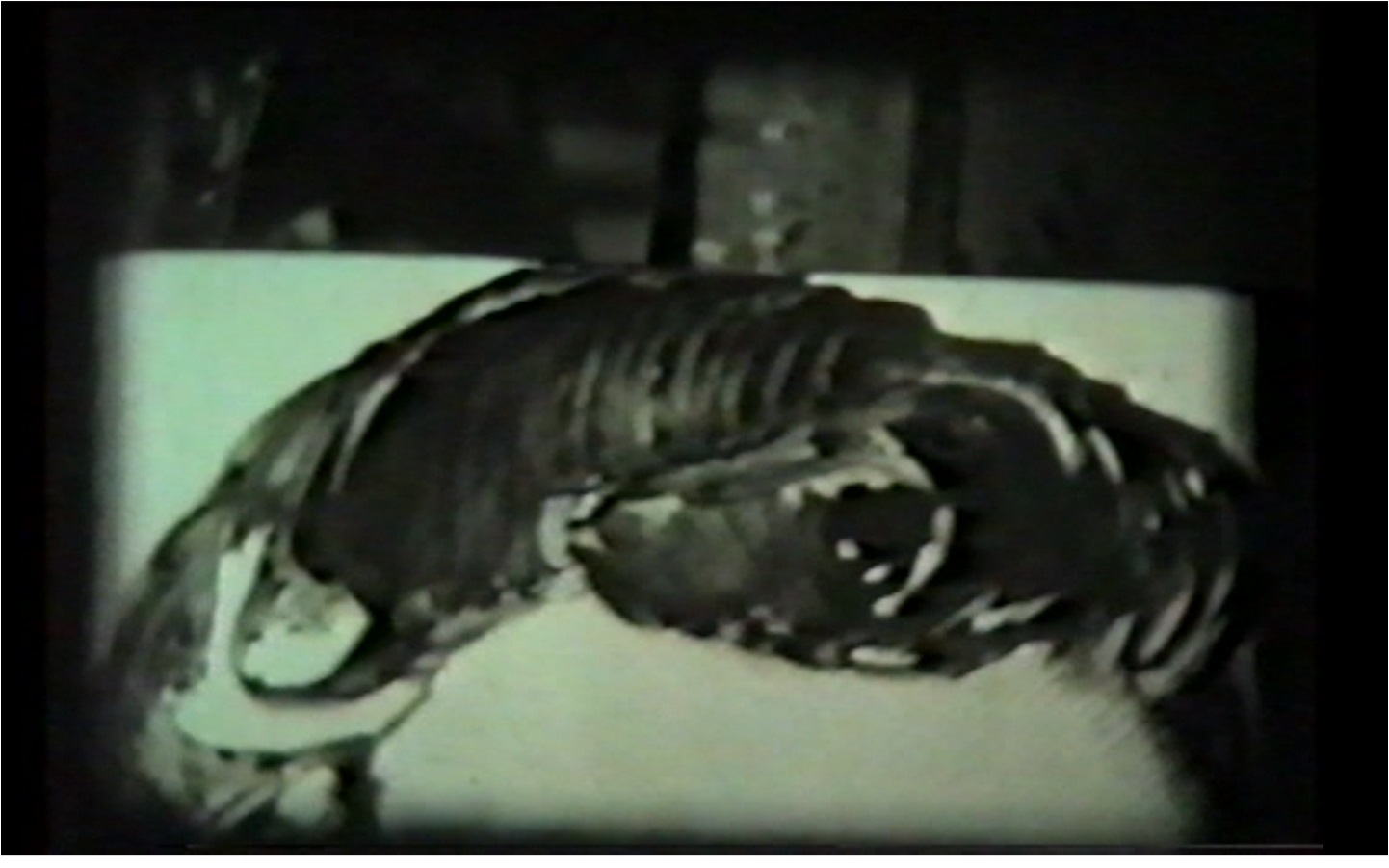
Repetition and Return
Coming back to the specific question of the nature of the relationship between the 2007 Postmortem Dialogue and the 1978 Dialogue we must take another look at the idea of reenactment and especially here in relation to time. In her work on historical reenactment, Rebecca Schneider writes: “In the syncopated time of reenactment, where then and now punctuate each other, reenactors in art and war romance and/or battle an ‘other’ time and try to bring that time – that prior moment – to the very fingertips of the present.”(Rebecca Schneider, Performing Remains. Art and war in times of theatrical reenactment (London and New York: Routledge, 2011) p. 2.) I will examine the act of inserting prior events into the here and now, of bringing the past back to the present in order to identify the unifying link between Grigorescu’s two Dialogues.
This aspect of reenactment is bolstered by another concept, which Freud called “repetition compulsion” (Wiederholungszwang). The psychoanalyst finds repetition in the tension between past and present, oblivion or repression and memory. When the patient repeats, it is because he doesn’t remember that an event has passed. To remember – and Freud emphasised this word by putting it in italics – is to locate the event in the moment that it happened, that is, in the past.(Sigmund Freud, “Erinnern, Wiederholen und Durcharbeiten” [1914], in Gesammelte Werke (London: Imago Publishing, 1945) p. 129.) To repeat is to do precisely the opposite, not remember but rather act (agieren), by bringing the past into the present. “[The patient] is obliged to repeat the repressed material as contemporary experience instead of, as the physician would prefer to see, remembering it as something belonging to the past.”(Freud, Beyond the Pleasure Principle [1920], translated by Anna Freud (London: The Hogarth Press, 1955) p. 18.)
It seems to me that the Freudian concept of repetition must explain the link between the two Dialogues of Grigorescu. The Postmortem Dialogue of 2007 “repeats” the Dialogue of 1978 inasmuch as the theme of the conversation with Ceausescu is taken up again and transposed to the present moment. Far from constituting a memorialisation of Romania’s history and a journey back in time, this conversation, to all intents and purposes, is understood to take place in 2007. More than seventeen years after his death, Ceausescu rises from the dead to converse with the artist. The discussion does not concern itself with the period in which Ceausescu lived. The president, who was executed in 1989, comes back to life instead to assess the contemporaneous state of the country.
This interpolation with the present features also in an anecdote Grigorescu often likes to tell. In 2007, the artist performed in the Transylvanian town of Sibiu. In all aspects, the performance resembled the first part of his 2007 film. Grigorescu and his assistant went for a walk wearing out-sized masks which bore the faces of Nicolae and Elena Ceausescu. A soundtrack accompanied them as they walked which consisted of a recording by Grigorescu making remarks typical of Ceausescu but which in fact he himself had written. He describes how at the end of the performance an elderly couple approached him to tell him that they had thought they were hearing the former president speaking. From down the years the past resurfaced and became present. In the recordings played during the performances filmed in Sibiu and Bucharest Grigorescu is heard shouting and straining his voice in order to sound like Ceausescu, without ever using the megaphone he is seen holding throughout. It’s as if the main concern here is to highlight the fact that the voice one naturally identifies as Ceausescu’s was in fact, the artist’s. To make the deceased president’s voice resonate in the present of the year 2007 is to give rise to Freudian repetition in its inability to consider the past as past.
 Postmortem Dialogue itself contains an element which helps when trying to envisage the unifying link between it and the 1978 Dialogue, namely that of return. We see this both in the return to the dialogue format of the 1978 film and in the resuscitation of the deceased president. The motif of the conversation with Ceausescu is revisited in the 2007 work in the way in which the presidential couple return to the site of their former home. There is a striking ghostly quality to Nicolae and Elena Ceausescu as they wander outside the People’s House.(Doubtless this explains why Klara Kemp-Welch mistakenly believes us to be dealing not with Nicolae and Elena Ceaucescu but the president and his son Nicu. The mix-up between Elena and Nicu Ceausescu allows the author to compare Grigorescu’s video to Shapespeare’s tragedy, Hamlet. See Klara Kemp-Welch, “Impossible Interviews with Ceausescu: Ion Grigorescu and the Dialogic Imagination,” in Ion Grigorescu. The Man with a Single Camera, Alina Serban, ed. (Berlin: Sternberg Press, 2013) p. 171: “The scene is entirely Shakespearean. Nicu-Grigorescu recalls the young Hamlet following the ghost of his father along the fortifications of Elsinore…”) The couple seem to haunt the Palace that they had had built. Similarly, Postmortem Dialogue is haunted by the 1978 Dialogue. According to Avery Gordon, haunting constitutes a discourse investigating both the past and the present, “The way of the ghost is haunting, and haunting is a very particular way of knowing what has happened or is happening.”(Avery F. Gordon, Ghostly Matters. Haunting and the Sociological Imagination [1997] (Minneapolis and London: University of Minnesota Press, 2008) p. 8.) As with repetition compulsion the ghosts’ return is due to the fact that the issues remain unresolved.
Postmortem Dialogue itself contains an element which helps when trying to envisage the unifying link between it and the 1978 Dialogue, namely that of return. We see this both in the return to the dialogue format of the 1978 film and in the resuscitation of the deceased president. The motif of the conversation with Ceausescu is revisited in the 2007 work in the way in which the presidential couple return to the site of their former home. There is a striking ghostly quality to Nicolae and Elena Ceausescu as they wander outside the People’s House.(Doubtless this explains why Klara Kemp-Welch mistakenly believes us to be dealing not with Nicolae and Elena Ceaucescu but the president and his son Nicu. The mix-up between Elena and Nicu Ceausescu allows the author to compare Grigorescu’s video to Shapespeare’s tragedy, Hamlet. See Klara Kemp-Welch, “Impossible Interviews with Ceausescu: Ion Grigorescu and the Dialogic Imagination,” in Ion Grigorescu. The Man with a Single Camera, Alina Serban, ed. (Berlin: Sternberg Press, 2013) p. 171: “The scene is entirely Shakespearean. Nicu-Grigorescu recalls the young Hamlet following the ghost of his father along the fortifications of Elsinore…”) The couple seem to haunt the Palace that they had had built. Similarly, Postmortem Dialogue is haunted by the 1978 Dialogue. According to Avery Gordon, haunting constitutes a discourse investigating both the past and the present, “The way of the ghost is haunting, and haunting is a very particular way of knowing what has happened or is happening.”(Avery F. Gordon, Ghostly Matters. Haunting and the Sociological Imagination [1997] (Minneapolis and London: University of Minnesota Press, 2008) p. 8.) As with repetition compulsion the ghosts’ return is due to the fact that the issues remain unresolved.
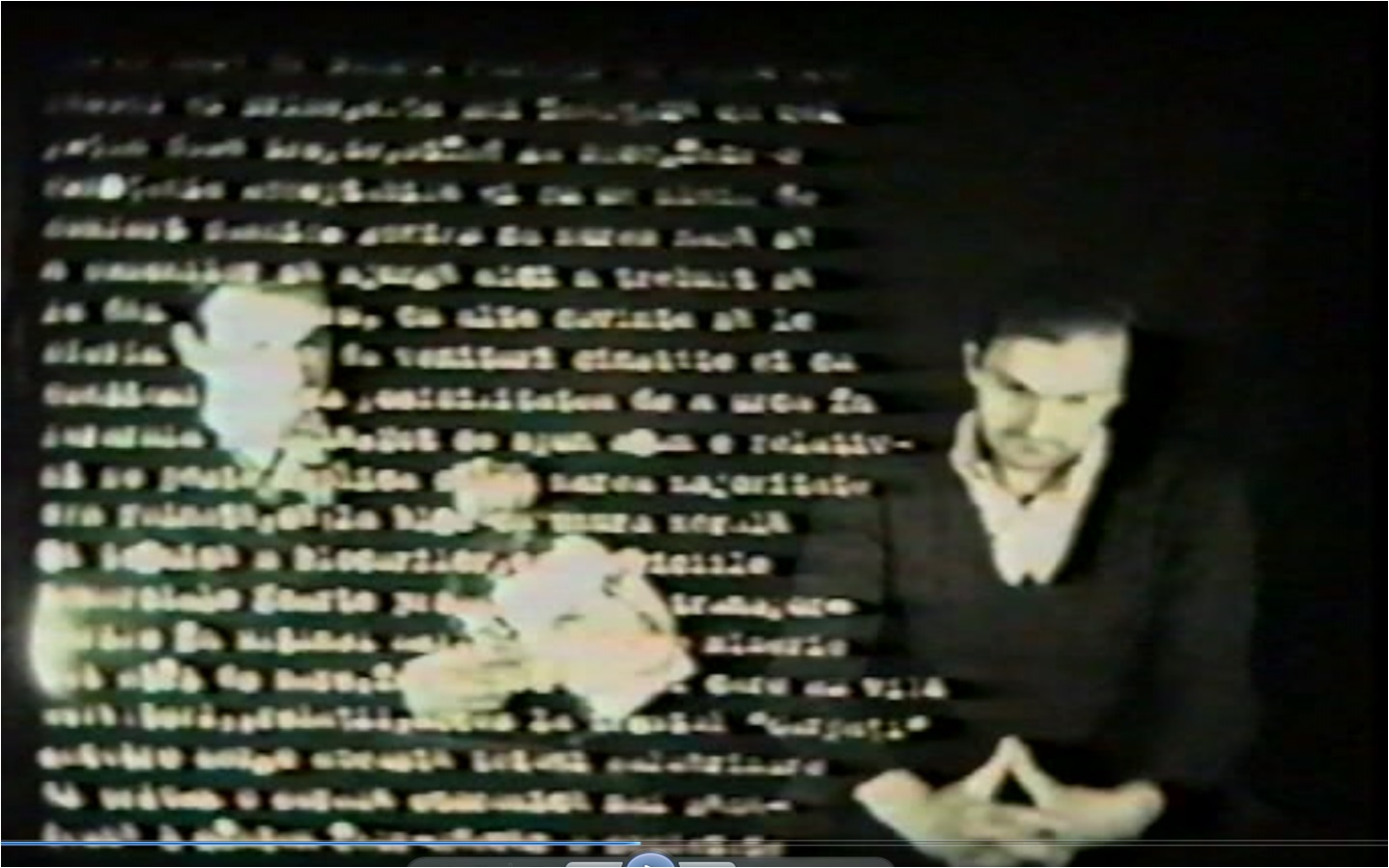 What links Postmortem Dialogue to the Dialogue of 1978 is certainly not,as this article has shown, the spirit of reconstruction. Nevertheless, the 2007 video can be considered a reenactment of the earlier work. Just as in Schneider’s definition of this term, the 2007 video extracts the 1978 film from the past and inserts it into the flux of the present. However this is not simply a question of past reappearing, as the combination of reenactment with the concepts of repetition and return above all recognises the continued existence of problems which have not been hitherto laid to rest. The past is not in the past. This is the point of intersection with Romanian history. In establishing a direct link between his two Dialogues with Ceausescu, Grigorescu highlights not only that Romania’s problems continue long after the execution of its former president but also that these must be addressed without forgetting that they date from the period of Ceausescu’s rule.
What links Postmortem Dialogue to the Dialogue of 1978 is certainly not,as this article has shown, the spirit of reconstruction. Nevertheless, the 2007 video can be considered a reenactment of the earlier work. Just as in Schneider’s definition of this term, the 2007 video extracts the 1978 film from the past and inserts it into the flux of the present. However this is not simply a question of past reappearing, as the combination of reenactment with the concepts of repetition and return above all recognises the continued existence of problems which have not been hitherto laid to rest. The past is not in the past. This is the point of intersection with Romanian history. In establishing a direct link between his two Dialogues with Ceausescu, Grigorescu highlights not only that Romania’s problems continue long after the execution of its former president but also that these must be addressed without forgetting that they date from the period of Ceausescu’s rule.
This article is part of the Special Issue on Reenactment in Eastern Europe. Articles in the issue include:
[su_menu name=”Reenactment”]

 Ileana Parvu is an Associate Professor of History and Theory of Art at the Geneva School of Art and Design. She edited Objects in Progress. After the Dematerialisation of Art (Geneva: M?tisPresses, 2012) and has written La peinture en visite. Les constructions cubistes de Picasso (Bern: P. Lang, 2007) and articles on the notion of object, on the avant-gardes, and on the notion of materiality in the art of the 80s and 90s. Her current research focuses on artistic making and techniques after Conceptual Art.
Ileana Parvu is an Associate Professor of History and Theory of Art at the Geneva School of Art and Design. She edited Objects in Progress. After the Dematerialisation of Art (Geneva: M?tisPresses, 2012) and has written La peinture en visite. Les constructions cubistes de Picasso (Bern: P. Lang, 2007) and articles on the notion of object, on the avant-gardes, and on the notion of materiality in the art of the 80s and 90s. Her current research focuses on artistic making and techniques after Conceptual Art.

